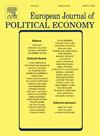物质与制度的公共产品供给:来自中国的证据
IF 2.4
3区 经济学
Q2 ECONOMICS
引用次数: 0
摘要
本文认为,政治和市场集中度水平解释了为什么发展中经济体经常在制度基础设施和法律能力方面投资不足。经济增长挑战了这种平衡,激励统治者投资于与实体基础设施互补的制度基础设施。统治者只有在能够获得更高的租金并保留有利于集中的机构的情况下,才会共同投资以扩大市场准入和规模。理论模型预测,随着市场集中度的提高,实物基础设施投资的增长速度要快于机构投资。利用省级煤炭储量份额作为市场集中度的衡量指标,对1997年至2006年中国数据进行的一项异中异分析显示,2000年(即中国加入WTO的前一年),市场集中度最高的四分之一省份的财政支出中,有形基础设施与制度性基础设施之比增长速度快了78%。本文章由计算机程序翻译,如有差异,请以英文原文为准。
Physical vs. institutional public goods provision: Evidence from China
This paper argues that political and market concentration levels explain why developing economies often underinvest in institutional infrastructure and legal capacity. Economic growth challenges this equilibrium, incentivizing rulers to invest in institutional infrastructure complementary to physical infrastructure. Rulers jointly invest to expand market entry and size only if they can secure higher rents and preserve institutions favoring concentration. The theoretical model predicts that physical infrastructure investment grows faster than institutional investment as market concentration rises. Using provincial coal reserve shares as an instrument for market concentration, a difference-in-differences analysis of Chinese data from 1997 to 2006 shows that the fiscal expenditure ratio of physical to institutional infrastructure increased 78% faster in provinces within the top market concentration quartile in 2000—the year before China joined the WTO.
求助全文
通过发布文献求助,成功后即可免费获取论文全文。
去求助
来源期刊

European Journal of Political Economy
Multiple-
CiteScore
3.40
自引率
10.00%
发文量
106
期刊介绍:
The aim of the European Journal of Political Economy is to disseminate original theoretical and empirical research on economic phenomena within a scope that encompasses collective decision making, political behavior, and the role of institutions. Contributions are invited from the international community of researchers. Manuscripts must be published in English. Starting 2008, the European Journal of Political Economy is indexed in the Social Sciences Citation Index published by Thomson Scientific (formerly ISI).
 求助内容:
求助内容: 应助结果提醒方式:
应助结果提醒方式:


